

Tutoriel sur la compréhension de la machine virtuelle Java. Avant de nous intéresser au bytecode Java, il est nécessaire de comprendre comment fonctionne dans les grandes lignes la JVM.

Tous les articles déjà publiés de la série portent le tag jvmhardcore. Le JRE est composé de l'API Java et de la JVM. Le rôle de la JVM est de lire une application composée de fichiers .class sous différentes formes (zip, jar, war, un simple tableau d'octets, etc.) à l'aide d'un chargeur de classes et de l'exécuter, ainsi que l'API Java.
D'une manière générale, une Machine Virtuelle (VM) est une implémentation logicielle d'une architecture physique ou hypothétique. Il existe deux types de machines virtuelles, les VM système et les VM applicatives. Secure Coding For Java - Une introduction.
Remote debugging avec Eclipse d'une application web sous Tomcat - Guillaume VIEL. Le débogage d'application web est pénible et qui n'a pas été usé par l'utilisation intensive de traces qui au final n'apportent rien, si ce n'est de pourrir un peu plus l'application et la rendre encore moins performante qu'avant...
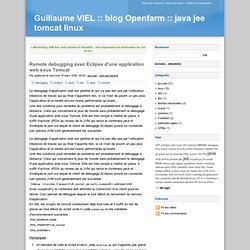
Une des solutions pour remédier au problème est probablement le débogage à distance. Java 8 Lambdas - A Peek Under the Hood. Java 8 was released in March 2014 and introduced lambda expressions as its flagship feature.
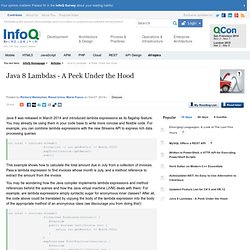
You may already be using them in your code base to write more concise and flexible code. For example, you can combine lambda expressions with the new Streams API to express rich data processing queries: int total = invoices.stream() .filter(inv -> inv.getMonth() == Month.JULY) .mapToInt(Invoice::getAmount) .sum(); This example shows how to calculate the total amount due in July from a collection of invoices. Pass a lambda expression to find invoices whose month is July, and a method reference to extract the amount from the invoice. Spring.
Java EE. Hibernate. Java tutorial for beginners. Yet Another JUnit Tutorial - JUnit in a Nutshell. JUnit seems to be the most popular testing tool for developers within the Java world.
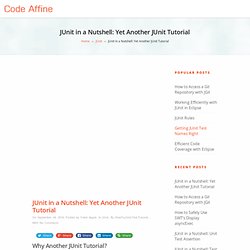
So it is no wonder that there have been written some good books about this topic. But I still meet quite often programmers, who at most have a vague understanding of the tool and its proper usage. Hence I had the idea to write a couple of posts that introduce the essential techniques from my point of view. The intention is to provide a reasonable starting point, but avoid daunting information flooding à la xUnit Test Patterns. Instead there are pointers to in depth articles, book chapters or dissenting opinions for further reading whenever suitable. So despite of the existing books and articles about testing with the tool, maybe the hands-on approach of this mini-series might be appropriate to get one or two additional developers interested in unit testing – which would make the effort worthwhile.
Let the games begin! Table of Contents Conclusion. Java news and resources. WildFly Homepage · WildFly. JTips. Le BDD mis en oeuvre avec JBehave. Javarevisited: Blog about Java Programming Tutorials, Examples, Design Patterns, Interview Questions and Answers, FIX Protocol, Tibco RV messaging, UNIX and Linux Commands, XML, SQL, MySQL, Oracle, jQuery, JavaScript,HTML, Multithreading, Collection, Erro. Announcing .. Gradle Tutorial Series. Welcome to a new blog series where I aim to cover the basics of Gradle, the build tool that not just everyone is talking about but adopting widely.

Companies, small and large have adopted this tool and while you might be familiar with Ant and Maven, it is time to take a look at Gradle. The need for writing this series has come about primarily due to my work with a few Google related technologies/frameworks. I use the Google Cloud Platform widely for my projects (both professional and hobby) and have primarily used Eclipse as my IDE for both Cloud Projects (running on Google App Engine) and front-end mobile applications (Android). With Google putting its weight behind Android Studio, one of the things that hit me immediately when I try to use Android Studio was the fact that it used Gradle as its build tool. My first experience with Android Studio and Gradle was one that cannot be described. This tutorial series will take you to a journey that covers the following: Cours Java et Eclipse de J.M. Doudoux. Java notify() and wait() examples.
This article contains two code examples to demonstrate Java concurrency.
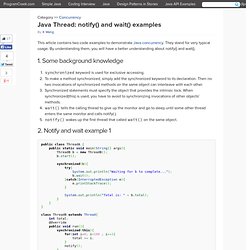
They stand for very typical usage. By understanding them, you will have a better understanding about notify() and wait(). 1. Some background knowledge synchronized keyword is used for exclusive accessing. 2. In the example above, an object, b, is synchronized. b completes the calculation before Main thread outputs its total value. Output: Waiting for b to complete... If b is not synchonized like the code below: The result would be 0, 10, etc. ICEfaces JSF Framework Overview. ICEfaces is an open-source Rich Internet Application (RIA) development framework based on the JavaServer Faces 2 standard.
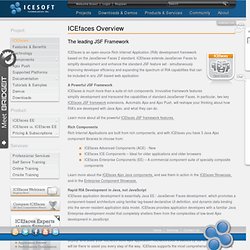
ICEfaces extends JavaServer Faces to simplify development and enhance the standard JSF feature set - simultaneously improving developer efficiency and expanding the spectrum of RIA capabilities that can be included in any JSF-based web application. A Powerful JSF Framework ICEfaces is much more than a suite of rich components.
Innovative framework features simplify development and transcend the capabilities of standard JavaServer Faces. In particular, two key ICEfaces JSF framework extensions, Automatic Ajax and Ajax Push, will reshape your thinking about how RIA's are developed with Java Ajax, and what they can do. Learn more about all the powerful ICEfaces JSF framework features. Introduction to Ajax4Jsf.